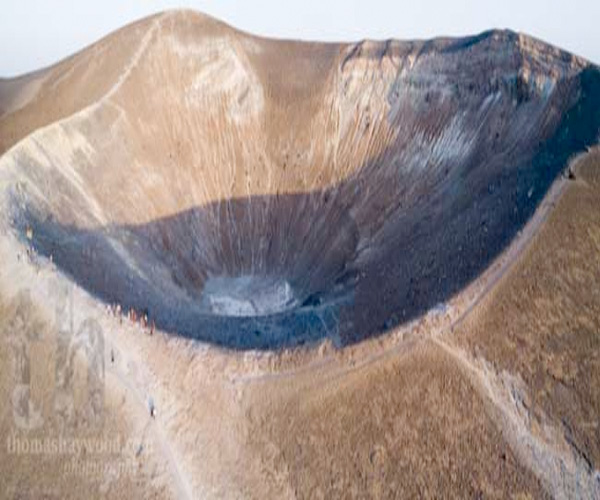Broadcast News
24/08/2017
Getting In A Lava About Drones

Volcanoes are to be found all over the world in their extinct, dormant and active forms. This one (pictured above) last erupted in 1888 and is dormant with the exception of the fumaroles (the sulphurous steam vents that smell like rotten eggs).
This is Vulcano in the Aeolian Islands just off the north coast of Sicily, Italy. The crater is at about 500m (1,640ft) above sea level and it was relatively straightforward to walk up there with a guide and to get the photo above by drone. I used a light and convenient DJI Mavic Pro.
Weather
The heat during the summer can be very draining and whilst we were there the daytime temperatures regularly reached 36ºC which made it necessary to climb in the early morning or in the evening. We took plenty of water to get there but no-one needed to have a pee; we all sweated what we drank! Climbing up a hill in this weather can be very physically demanding.
So what causes Volcanoes?
Volcanoes are effectively nature's geological safety valve. So, simply explained, this region is where the African Tectonic Plate dives under the European Plate, melting as it dives under. This forms magma and pressure builds up below. Weaknesses in the earth's crust allow for the magma to escape and thus volcanoes start to form.
Stromboli
Mt Stromboli is one of Italy's three active volcanoes. It has been continually erupting for the past 2,000 years. It is a small island located in the Tyrrhenian Sea just off the north coast of Sicily. It rises up to 928m (3,044ft) out of the sea so you can normally only get to the island by boat. Rules now dictate that you can only go up the volcano in guided groups for safety reasons.
We took 2 1⁄2 hours to climb the mountain – 1 1⁄2 hours to descend (slow progress) and we sweated two to three litres of water in the process due to the heat. We left from the village at about 5.30pm in the afternoon because of the lower heat and arrived at the crater summit around sunset. As you get to the top you leave the vegetation behind and you see a desolate "moon-scape" where there is no life.
The nature of the volcano is an explosive one, with short moderate and often unpredictable explosions. This produces incandescent volcanic bombs with ash and rock fragments whose height into the air can vary greatly.
Flying at the crater
As we approached the summit, we got a taste of what was to come. A big rumbling boom cracked around the mountain and a big plume of fiery molten lava shot into the air.
At the summit, under the guidance of the Volcano Guides, I was able to get out my Mavic Pro to get some shots. There were several issues that made flying a drone very difficult.
The rapidly failing light made it very challenging to get correct exposures. The camera aperture on the Mavic is very small, making it almost impossible to get a decent quality video in anything other than ambient light. However, when set to manual exposure in photography stills, I was able to get a few decent shots. That evening we were very lucky to have virtually no wind so I was able to set the shutter speed to two seconds (very steady drone!).
The nature of this volcano is that it can be very unpredictable. With nearly 8 or 9 vents, you did not know where the next explosion would come from. It did nearly get hit by some flying lava, even at 50m above the crater and I knew there were hazards – you fly at your own risk!
One thing I did notice is that the picture signal did get interfered with on several occasions. I had to come back and land to reset the drone. I spoke to another pilot with the same model of drone afterwards. On another night he encountered the same issues, plus it knocked out the GPS too – he had to return to take-off point by flying the machine manually).
This begged the question what was going on there? Normally as pilots we think of iron rich materials like steel and rocks as well as radio signals that can very much interfere. Fortunately, with many thanks to Rory Gilles of Shetland Flyer, he was able to shed light on the situation: "Geologist head on! When iron rich rock (or any ferromagnetic material) reaches a certain temperature (called the Curie temperature) it becomes paramagnetic and actually has very little magnetism compared to the ferromagnetic properties of cool rock. Molten lava is well above the Curie temperature so will influence the compass less than the surrounding geomagnetism. I would suggest that the most likely cause is ash material in the air affecting the propagation or blocking GPS signals."
The effort was very much worth it and I was able to get some cracking shots from the drone (and the stills camera) in the end.
Thomas Haywood is a drone pilot at Thomas Haywood Aerial Photography.
photos@thomashaywood.com
This is Vulcano in the Aeolian Islands just off the north coast of Sicily, Italy. The crater is at about 500m (1,640ft) above sea level and it was relatively straightforward to walk up there with a guide and to get the photo above by drone. I used a light and convenient DJI Mavic Pro.
Weather
The heat during the summer can be very draining and whilst we were there the daytime temperatures regularly reached 36ºC which made it necessary to climb in the early morning or in the evening. We took plenty of water to get there but no-one needed to have a pee; we all sweated what we drank! Climbing up a hill in this weather can be very physically demanding.
So what causes Volcanoes?
Volcanoes are effectively nature's geological safety valve. So, simply explained, this region is where the African Tectonic Plate dives under the European Plate, melting as it dives under. This forms magma and pressure builds up below. Weaknesses in the earth's crust allow for the magma to escape and thus volcanoes start to form.
Stromboli
Mt Stromboli is one of Italy's three active volcanoes. It has been continually erupting for the past 2,000 years. It is a small island located in the Tyrrhenian Sea just off the north coast of Sicily. It rises up to 928m (3,044ft) out of the sea so you can normally only get to the island by boat. Rules now dictate that you can only go up the volcano in guided groups for safety reasons.
We took 2 1⁄2 hours to climb the mountain – 1 1⁄2 hours to descend (slow progress) and we sweated two to three litres of water in the process due to the heat. We left from the village at about 5.30pm in the afternoon because of the lower heat and arrived at the crater summit around sunset. As you get to the top you leave the vegetation behind and you see a desolate "moon-scape" where there is no life.
The nature of the volcano is an explosive one, with short moderate and often unpredictable explosions. This produces incandescent volcanic bombs with ash and rock fragments whose height into the air can vary greatly.
Flying at the crater
As we approached the summit, we got a taste of what was to come. A big rumbling boom cracked around the mountain and a big plume of fiery molten lava shot into the air.
At the summit, under the guidance of the Volcano Guides, I was able to get out my Mavic Pro to get some shots. There were several issues that made flying a drone very difficult.
The rapidly failing light made it very challenging to get correct exposures. The camera aperture on the Mavic is very small, making it almost impossible to get a decent quality video in anything other than ambient light. However, when set to manual exposure in photography stills, I was able to get a few decent shots. That evening we were very lucky to have virtually no wind so I was able to set the shutter speed to two seconds (very steady drone!).
The nature of this volcano is that it can be very unpredictable. With nearly 8 or 9 vents, you did not know where the next explosion would come from. It did nearly get hit by some flying lava, even at 50m above the crater and I knew there were hazards – you fly at your own risk!
One thing I did notice is that the picture signal did get interfered with on several occasions. I had to come back and land to reset the drone. I spoke to another pilot with the same model of drone afterwards. On another night he encountered the same issues, plus it knocked out the GPS too – he had to return to take-off point by flying the machine manually).
This begged the question what was going on there? Normally as pilots we think of iron rich materials like steel and rocks as well as radio signals that can very much interfere. Fortunately, with many thanks to Rory Gilles of Shetland Flyer, he was able to shed light on the situation: "Geologist head on! When iron rich rock (or any ferromagnetic material) reaches a certain temperature (called the Curie temperature) it becomes paramagnetic and actually has very little magnetism compared to the ferromagnetic properties of cool rock. Molten lava is well above the Curie temperature so will influence the compass less than the surrounding geomagnetism. I would suggest that the most likely cause is ash material in the air affecting the propagation or blocking GPS signals."
The effort was very much worth it and I was able to get some cracking shots from the drone (and the stills camera) in the end.
Thomas Haywood is a drone pilot at Thomas Haywood Aerial Photography.
photos@thomashaywood.com
Top Related Stories
Click here for the latest broadcast news stories.
21/02/2012
LEN:'We Were Able To Evolve When Our Competitors Could Not'
Regional Film and Video have caught up with Clive Baty of LEN, a leading UK specialist in passive signal enhancement. He has given us the run down on
LEN:'We Were Able To Evolve When Our Competitors Could Not'
Regional Film and Video have caught up with Clive Baty of LEN, a leading UK specialist in passive signal enhancement. He has given us the run down on
06/06/2016
Flying TV Goes 6K On Helicopters & Drones
Since 2003 Flying TV has led the way in producing high quality, sensibly-priced aerial imagery for the television market. From our inception by broadc
Flying TV Goes 6K On Helicopters & Drones
Since 2003 Flying TV has led the way in producing high quality, sensibly-priced aerial imagery for the television market. From our inception by broadc
22/02/2010
Obscura Lights Hard Rock Cafe's Rock Wall
Hard Rock Cafe in Las Vegas has developed a new way for visitors to interact with signature rock’n’roll memorabilia collection: a massive 5.5m wide, 1
Obscura Lights Hard Rock Cafe's Rock Wall
Hard Rock Cafe in Las Vegas has developed a new way for visitors to interact with signature rock’n’roll memorabilia collection: a massive 5.5m wide, 1
18/08/2017
Extreme Facilities – Benefits Of Working With Drones
From 2012 we have seen an overwhelmingly serge of professional activity ranging through all forms of production from Motorsport to Architecture, Comme
Extreme Facilities – Benefits Of Working With Drones
From 2012 we have seen an overwhelmingly serge of professional activity ranging through all forms of production from Motorsport to Architecture, Comme
30/06/2017
Drones – The New Tool For Roof Surveys
Roofs need to be surveyed. That much is certain, either because the rain's getting in, or because there is a change of owner and someone needs a recor
Drones – The New Tool For Roof Surveys
Roofs need to be surveyed. That much is certain, either because the rain's getting in, or because there is a change of owner and someone needs a recor
15/06/2017
Drones And Licensing...
These days with so many drones about, the novelty amongst people is starting to fall by the wayside. People can go down to a hobby shop or online to b
Drones And Licensing...
These days with so many drones about, the novelty amongst people is starting to fall by the wayside. People can go down to a hobby shop or online to b
12/06/2017
Drones: The Future Of Aerial Filming
As gear has become smaller, lighter and more sophisticated, aerial filming no longer has to involve expensive helicopters and static cranes. Aerial sh
Drones: The Future Of Aerial Filming
As gear has become smaller, lighter and more sophisticated, aerial filming no longer has to involve expensive helicopters and static cranes. Aerial sh
23/02/2017
Drones Used To Film London Oratory Choir
So often nowadays we associate drones with anything from the tools of war to something that has the potential to invade our privacy, but used in the s
Drones Used To Film London Oratory Choir
So often nowadays we associate drones with anything from the tools of war to something that has the potential to invade our privacy, but used in the s
28/01/2016
Aerialworx – Drones In The Atlantic
In September 2015, Aerialworx were approached by Talisker Whisky to film their 2015 Atlantic Challenge, the world's toughest rowing race. More people
Aerialworx – Drones In The Atlantic
In September 2015, Aerialworx were approached by Talisker Whisky to film their 2015 Atlantic Challenge, the world's toughest rowing race. More people
19/04/2010
Flying TV Rising Above The Ashes
A company dedicated to the skills of aerial filming are continuing to operate legally and safely at a time when commercial airlines are grounded due t
Flying TV Rising Above The Ashes
A company dedicated to the skills of aerial filming are continuing to operate legally and safely at a time when commercial airlines are grounded due t
06/02/2020
Austrian Audio OC818 Mic 'Stands Head And Shoulders' Above The Rest
Outhouse Studios in the UK recently tested out an Austrian Audio OC818 mic, declaring that it 'stands head and shoulders' above any other microphone.
Austrian Audio OC818 Mic 'Stands Head And Shoulders' Above The Rest
Outhouse Studios in the UK recently tested out an Austrian Audio OC818 mic, declaring that it 'stands head and shoulders' above any other microphone.
11/12/2019
New FreeStyle Mini Punches Above Its Weight
Kino Flo Lighting has unveiled the Mini panel, the company's newest FreeStyle LED system for production lighting. The compact FreeStyle Mini LED from
New FreeStyle Mini Punches Above Its Weight
Kino Flo Lighting has unveiled the Mini panel, the company's newest FreeStyle LED system for production lighting. The compact FreeStyle Mini LED from
10/08/2018
Programme Segmentation – A Cut Above The Rest
As all regular exhibitors at IBC know, the summer months are usually occupied answering the same question from the industry, year after year, namely:
Programme Segmentation – A Cut Above The Rest
As all regular exhibitors at IBC know, the summer months are usually occupied answering the same question from the industry, year after year, namely:
08/03/2016
Getting Above The Competition
Hague Camera Supports have just announced a variety of new products which will literally raise you above the competition. Hot on the heels of the Hagu
Getting Above The Competition
Hague Camera Supports have just announced a variety of new products which will literally raise you above the competition. Hot on the heels of the Hagu
10/11/2010
SOOM Flies Above The Crowd
Videographer Ajay Johnson travelled across the United States while shooting Sea to Shining Sea, a documentary following 15-year-old Kimberly Anyadike'
SOOM Flies Above The Crowd
Videographer Ajay Johnson travelled across the United States while shooting Sea to Shining Sea, a documentary following 15-year-old Kimberly Anyadike'















